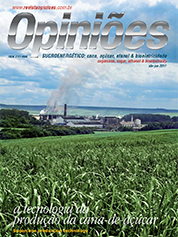Adriano Thiele
Executive Director of Operations at JSL
Op-AA-28
Reducing emissions in logistics
The productive sector, as well as the financial market, increasingly tend to favor companies ready for the low carbon economy. In the sugar and ethanol industry, given that sugarcane cutting, loading and transporting (CLT) processes are part of the end product’s production chain, regardless of whether the end product is ethanol, sugar or electric energy obtained by burning bagasse, companies need to do research on opportunities to reduce emissions in such operations.
As long as vehicle manufacturers are unable to offer commercial alternatives that allow for the systematic use of “clean” fuels in CLT equipment, the solution is to develop means to achieve a more efficient operation of CLT equipment by, for example, investing in the renewal and modernization of the truck fleet, as well as in the improvement of machinery.
One estimates that a 40-ton truck used to consume about 55 liters of diesel to travel 100 km in 1966. Twenty years later, to travel that same distance, 36 liters were needed and, between 2001 and 2010, only 34 liters. To reduce consumption means economy and lower emission levels.
The transportation of sugarcane from farms usually takes place under adverse and severe operational conditions, often on poorly maintained dirt roads and unfavorable topography. The development of engineering and technology has made it possible for companies specialized in this type of transportation to optimize truck configurations for each application, in partnership with the auto companies, which run the calculations on specific computer programs.
Customization allows adjusting the desired speed to the best possible engine rotation. Thus, trucks operate most of the time at ideal engine operating conditions and with minimal fuel consumption, i.e., at a better diesel per kilometer average.
To illustrate: at JSL, for transportation in forestry and sugar and ethanol applications using the same type of vehicle – a specific 6X4 truck category, with the same HP capacity, five different categories were defined for different types of terrain and topography. Customization focuses mainly on gear relations, reduction rates, type of gearbox, between axle distance and the fifth wheel.
However, to have a new fleet with the best configuration for each type of operation is no certainty of success. The equipment must be properly operated, at ideal rotations, gear relations, and speeds. This prevents premature wear of components, further reducing fuel consumption. In addition, efficient operating greatly reduces risks related to safety.
That brings us to the third critical success factor: availability of qualified manpower. Here, again, we can associate with technology. High performance onboard computers for telemetry cost between 1 and 2% of a truck’s price. This kind of equipment allows defining ideal operation parameters for each vehicle (RPM, engine braking utilization, speed, emergency braking, high-speed acceleration from standstill, gear use, pressure, temperature, etc).
After defining the parameters, these computers monitor the operating in real time and register possible violations. We can thus identify operators that need training and the main nonconformities. Recent application of this technology on 40 trucks showed that in the first weeks 12% of drivers committed 55% of the pre-established parameter violations.
With specific targeted training, after 3 months, the monthly violations were reduced from almost 30,000 to close to zero. With equipment being operated according to almost ideal parameters, the fuel consumption reduction was of 17.3%. Less burnt fuel means less CO2e (carbon dioxide equivalent) in the atmosphere.
According to the FBDS (Brazilian Foundation of Sustainable Development), burning 1 liter of diesel emits 2.68 kg of CO2e. One hectare of forest, aged 20 to 30 years, sequesters the equivalent of 290 tons of CO2e. With savings of 17.3% in diesel consumption by the 40 trucks, in a five-year period, 8,900 tons of CO2e were prevented from being expelled to the atmosphere.
To sequester that amount, 310,000 m2 of forest would be needed over a 20 to 30 year period. We often think that alternatives to increasing productivity and reducing costs always go in the opposite direction of environmental preservation. This experience shows us that we can combine these two objectives of responsible companies.




